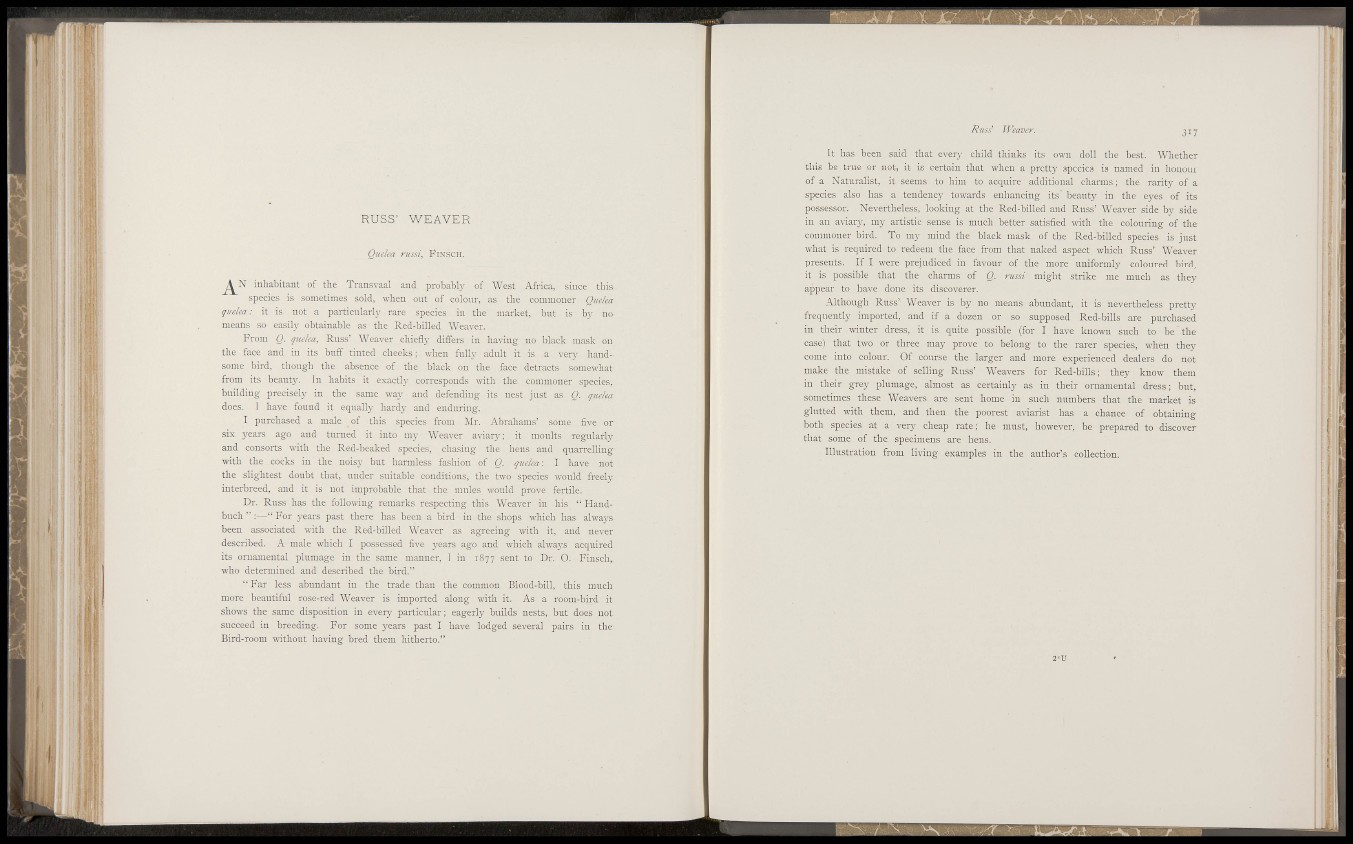
I
• -i í;
R U S S ' WEAVER
Ondea nissi, FINSCH.
^ ^ N inhabitant of the Transvaal and prohabl)- of West Africa, since this
species is sometimes sold, when out of colour, as the commoner Qnclea
quelea: it is not a particnlarh' rare species in the market, but is b)' no
means so easilj- obtainable as the Red-billed AVeaver.
From Q. qudca, Russ' Weaver chiefly differs in having no black mask On
the face and in its buff tinted cheeks; when fulh- adult it is a very handsome
bird, though the absence of the black on the face detracts somewhat
from its beauty. In habits it exactly corresponds with the commoner species,
building precisely in the same way and defending its nest just as O. quelea
does. I have found it equally hardy and enduring.
I purchased a male of this species from Mr. Abrahams' some five or
six years ago and turned it into my Weaver aviary; it moults regularly
and consorts with the Red-beaked species, chasing the hens and quarrelling
with the cocks in the noisy but harmless fashion of Q. qnelca •. I have not
the slightest doubt that, under suitable conditions, the two species would freely
interbreed, and it is not improbable that the mules would prove fertile.
Dr. Russ has the following remarks respecting this Weaver in his " Handbuch
" :—"For years past there has been a bird in the shops which has alwa3's
been associated with the Red-billed Weaver as agreeing with it, and never
described. A male which I possessed five years ago and which always acquired
its ornamental plumage in the same manner, I in 1877 sent to Dr. O. Finsch,
who determined and described the bird."
" Far less abundant in the trade than the common Blood-bill, this much
more beautiful rose-red Weaver is imported along with it. As a room-bird it
shows the same disposition in every particular; eagerly builds nests, but does not
succeed in breeding. For some years past I have lodged several pairs in the
Bird-room without having bred them hitherto."
Russ' Weaver. 317
It has been said that ever}- child thinks its own doll the best. Whether
this be true or not, it is certain that when a pretty species is named in honour
of a Naturalist, it seems to him to acc[uire additional charms; the rarity of a
species also has a tendenc}' towards enhancing its' beauty in the eyes of its
possessor. Nevertheless, looking at the Red-billed and Russ' Weaver side bj' side
in an aviary, my artistic sense is much better satisfied with the colouring of the
commoner bird. To my mind the black mask of the Red-billed species is just
what is required to redeem the face from that naked aspect which Russ' Weaver
presents. If I were prejudiced in favour of the more uniformly coloured bird,
it is possible that the charms of Q. russi might strike me much as they
appear to have done its discoverer.
Although Russ' Weaver is by no means abundant, it is nevertheless pretty
frecjuently imported, and if a dozen or so supposed Red-bills are purchased
in their winter dress, it is quite possible (for I have known such to be" the
case) that two or three may prove to belong to the rarer species, when they
come into colour. Of course the larger and more experienced dealers do not
make the mistake of selling Russ' Weavers for Red-bills; they know them
in their grey plumage, almost as certainly as in their ornamental dress; but,
sometimes these Weavers are sent home in such numbers that the market is
glutted with them, and then the poorest aviarist has a chance of obtaining
both species at a ver}^ cheap rate; he must, however, be prepared to discover
that some of the specimens are hens.
Illustration from living examples in the author's collection.
2-u
3
• t
' r r I
1 - 1